Ian Wight
Engaging the Integral/Professional Interface
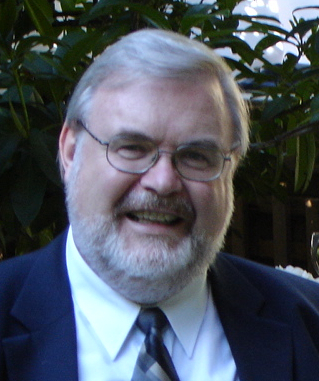
Ian Wight
I am feeling a yearning for the company of like-minded and like-hearted folks: integral aficionados explicitly valuing their professional identity; evolving professionals explicitly cultivating integral sensibilities. I therefore make this particular offering very much in the spirit of my own integrally-informed sense of Leadership – as Service – for Good, in Love, with a Smile. Might we – together – constitute a field, worth tilling, at the integral/professional interface?
This is a report – from the field – on some of my efforts to exercise such leadership, and pursue such inquiries, over the past decade or so. It represents one of my attempts to introduce and apply integral perspectives in the context of graduate professional education (the Masters in City Planning program, in the Faculty of Architecture, University of Manitoba, in Winnipeg, Canada). It features what has been emerging around my work on shifting ‘from practice to praxis’, in the context of a capstone course on Professional Practice – a course that gradually evolved into an integrally-informed ‘professional-self design’ studio[i].
The formative context has been Canadian, mid-Canadian to be precise (Manitoba is often regarded as Canada’s ‘key-stone’ province), located in a classic mid-sized, ‘middle-of-the-road’ Canadian city, featuring the oldest (un-interrupted) graduate professional planning education program in Canada. I taught in the program from 1994 to 2014, and headed the program from 2003 to 2008 – a formative period for what is offered here. Like many others around the world, it is an accredited, institute-recognized, professional program, expected to deliver an education in professional planning, with an essentially ‘modern’ professionalism in view.
Because of my direct exposure to integral framings (from around 1998)[ii] I naturally began to wonder about ‘integral professionalism’, and how this might manifest in a program such as ours. I came to view professionalism, quite consciously and deliberately, through an integral lens; it was given an integral cast, and the main initial manifestation was in terms of integrally-informed journaling in support of some praxis-making, in the Professional Practice course (Friesen and Wight, 2009). A ‘preliminary praxis statement’ became the outcome of some ‘professional-self design’, the praxis having the form of a unique integration of each student’s theory studies, practice experiences, and personal values/beliefs.
Through an integral lens, the course became very student-centred, with the ultimate focus being placed on the individual – more precisely the whole person – that is the professional, being professional, and enacting professionalism. What emerged from my countenancing of an integral professionalism was the possibility of what I came to render as (integrally-informed) professional-self design – building on the notion of design as the integration of perception, intention and making (another direct outgrowth of my immersion, as a planner, in a school of design). Thus, professional education became for me very much the education of professionals in them-selves (rather than an education in their fields or disciplines). I came to see that the object and subject of the education was effectively the students themselves as professionals-in-the making, through their own professional-self design (Wight, 2014). And then some deeper and wider questions started arising, and some hypothesizing, that I hope might also have some appeal for ILR readers especially.
What might a more explicit integral perspective contribute to advancing professional education? My hunch is that the integral/professional interface is a potential venue for the exercise of explicit leadership – for advancing professional education, and for achieving an integral advance on the current status quo. For example, can we contemplate a more integral professionalism? Or might tomorrow’s integrals become – in essence – a form of advance on today’s professionals? What leadership, in an education context, might be required for tomorrow’s ‘professionals’ to merit the moniker of ‘integrals’ – conceived potentially as ‘agents of the next enlightenment’?
I now realize that I have been increasingly exercised by such questioning over the past decade or so. It has effectively become a focus of my integral transformative practice in my professional milieu. Tentatively, reflectively and experimentally, I have been leading myself in a protracted ‘living’ with this questioning. It has been essentially self-leadership – an integral communing with my emerging professional-educator self. It would be good to have more company on this ‘work-out’.
I associate an integral framing with comprehensiveness, balance and inclusiveness; for myself it is consciously whole-seeking, valuing the uniting of multiple perspectives, while being intrinsically developmental. It is in effect essentially evolutionary, conferring an underlying imperative around whole-making; I have come to invoke a meaning of ‘evolving’ as ‘ever-more-whole-making’.
Extending – while transcending – ‘modern’ professionalism, my engagement of the integral/professional interface thus naturally facilitates a more comprehensive, balanced and inclusive investigation of the inner dimensions of integrity and integration – and not simply their outer manifestations. Significantly for myself, an integral perspective appears to enable not only a better meshing of the personal and the professional, but also a new integration – or re-integration – of the spiritual.
I invite you to position yourself at your integral/professional interface, and notice what comes up for you as you join me in this exploration. I hope to convey some processing of my experience so far, pursuing an integral approach to the education of professionals-in-the-making, beginning with an exploration of praxis – as an advance on practice – as a key distinction. First I explore what I have come to sense, and presence, around praxis as a (professional development) place for meshing the personal and the professional. Next I wonder about praxis as a prime place for integrating the spiritual (or rehabilitating a form of the spiritual) into the act of professing, invoking the spirit in praxis. As you encounter my explorations and wonderings, I would be very curious about what may arise for yourself – in the vicinity of the integral/professional interface, and especially as regards your sensing, and presencing, around your own praxis.
Praxis – A Place for Meshing the Personal and the Professional?
Teaching a Professional Practice class for 20 years has made for some pretty intense and protracted reflection on the essence of ‘practice’. I have come to the position that professionals often seem to revere practice, but rarely give it an explicit thought; rather, it is a given, that we don’t always get. Praxis, by contrast, definitely feels different to myself. I sense that, once we get ‘it’, it is always with us, always in us, always ‘on’. Praxis – as I understand it – embraces practice; it transcends and includes it. Practice is more habit and routine – going through prescribed motions. For myself, praxis is essentially transformative – an ongoing evolution, on a trajectory to the ever-more-whole. I would assert that our practice may have us, but we can make our praxis – if we have a mind to… and a heart, and a soul. In fact, praxis is potentially where our spirit also shows up, big time.
Praxis = Theory (Studies) + Practice (Experiences) + Values/Beliefs (Prof-essence)
Praxis is obviously proving foundational and fundamental in my current action research program: Evolving Professionalism Beyond the Status Quo – Contemplating the education of the agents of the Next Enlightenment. In my case I am envisaging praxis as an integration of what I have made from the totality of my received theory, my practice experiences, and my operative values and beliefs (my ‘prof-essence’ – the essence with/from which I profess). A unique meshing of my knowing + doing + being, it is a personal ‘making’ that contributes to making me more of a professional, more consciously professional, more embodied as a professional.
I am also advancing praxis as a foundational and fundamental ‘making’ of a professional, as part of a triad of such makings, including what I currently describe as ethos (inter-personal, and inter-professional) and poiesis (trans-personal, and trans-professional) (Wight, 2012). Here I focus on praxis, but would ask that readers try to conceive of this as part of the praxis/ethos/poiesis triad – rather than in isolation. The triad actually conveys for myself a more integral sense of praxis, as Praxis; I am contemplating something that ranges well beyond conventional notions of practice, but which may come closer to an integral manifestation of practice.
I am therefore situating praxis-making as a professional development place[iii], with praxis as part and parcel of the making of professionals – perhaps the key piece of what a professional ‘makes’. Based on my own experience I would encourage you to think of your praxis as the foundational element of your professional-self design; it has to do with what you want to ‘make’ of yourself, as a professional. It is your creation, your design, your story – the story you tell the future about what you ‘profess’, in response to the kinds of questions we ask in Sidebars 1, 2 and 3.
Praxis-Making: Negotiating Our Inner Professional Edge
In essence, for myself, praxis-making involves making an object of a subject, namely, my whole Self – as a whole person, i.e. implicating body, mind, soul and spirit (think of this as being more ‘comprehensive’). It involves being objective, subjectively (being ‘rational’, on our own behalf). And being in service to our own integration, as a worthy agent of integration involving others (being ‘integrative’). Ultimately, it involves better ‘knowing thyself’ – the guiding rule of Socrates, but – with a nod to Descartes – this could now also involve more consciously ‘being thyself’ (being ‘together’, on the inside and on the outside). This is the place of praxis-making, featuring connections, to get at our professional essence, our ‘prof-essence’.
Think of praxis-making as an exercise in negotiating our inner professional edge, with our blinkers off, with our blind-spots exposed. Our professionalism is not set in stone – think of it as something that can, and does, evolve. Have in mind the possibility of becoming more than a conventional professional, perhaps rehabilitating some valuable elements of primal professionalism, while attempting to reach out beyond modern professionalism. This might be towards an inter-professionalism of sorts, and then evolving a meta-professionalism – in and through our professing.
In a sense, at its most lively, such (integrally-informed) praxis-making may be mainly for ‘meta-professionals-in-the-making’, regarding their praxis (along with a complementary ethos, and a propensity for poiesis) as an intrinsic aspect of their make-up. Could this be you? The associated vision-logic has me conceiving such ‘meta-professionals’ as operating beyond modern professionalism, beyond even post-modern professionalism – transcending, while including, what has gone before. Realization of such a vision begins with a sense of our praxis; what might this entail? (See Fig. 1).
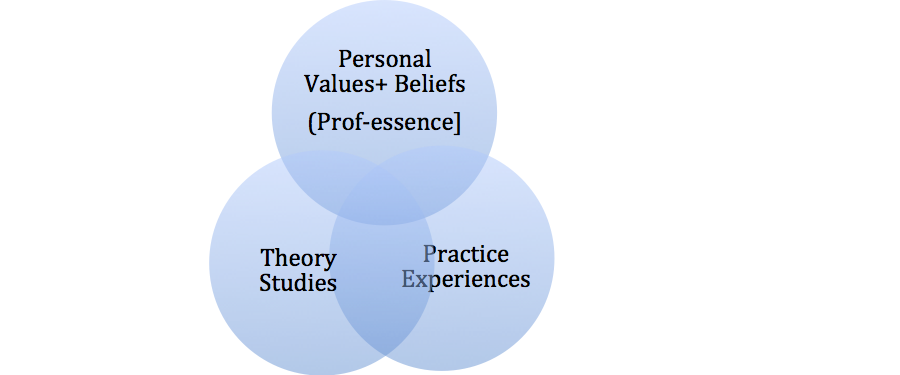
Figure 1. A Professional Development Place – of Intersection and Integration
In a professional education context, I envisage my praxis right at the intersection of – and as an integration of – all my ‘theory studies’ (knowledge/knowing), my ‘practice experiences’ (action/doing) and my ‘personal values + beliefs’ (essence/be-ing). It is like a ‘sweet’ spot, right in the middle, reflecting my core – where knowing, doing and believing meet, and which feed off one another, always evolving.
Theory Studies: This is where my head rules, the work of the mind – at work; the place of my perceptions and interpretations, of patterns that matter…. thinking, reasoning; mental, perceptual.
Practice Experiences: This is where my body is at work; hands-on; the place of my behaviours, doings, realizations… acting, enacting; practical, radical.
Personal Values and Beliefs: This is where my heart is at work … and soul, en route to engaging myself as a whole; the place of my personal touch – the place of my feeling, sensing and essencing; my ‘prof-essence’.
The latter (my personal values and beliefs) represents an inner place with outer manifestations, the main conduit to my praxis. Yet I see this as mostly a place that is accorded short shrift by many modern professionals; clearly – for myself – it merits much more explicit attention. Critically, it informs the ‘I’ (rather than the ‘me’) of professionals; I believe it goes to what a professional ‘stands for’, what a professional ultimately ‘professes’ – from, or out of. Ideally, this ‘I’ – my Self in this case – will find expression in a life that is ‘undivided’ (Palmer, 2004); a whole being at work in the world. As such this feels to me as much more than a special combination of theory and practice; I sense that there is also a spirit of sorts at work… influencing the interpreting and the discerning, potentially fundamental and transformational. All three elements are mobilized to achieve praxis, but our personal values and beliefs, captured in our ‘prof-essence’, seem to me to merit a central/pole positioning – transcending and integrative. It is our inner professional leading-edge (See Figure 2).
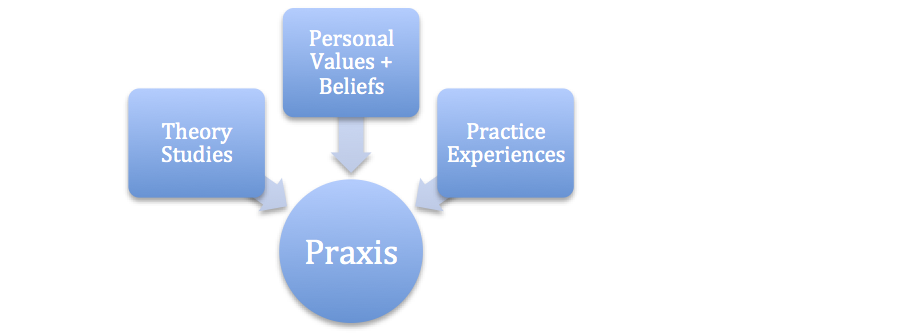
Figure 2. The Elements of Praxis
Praxis: The Prime – and Primal – Making of an Aspiring Professional?
My exploration at the integral/professional interface has led me to some working hypotheses about transformative professional education, most notably around a shift in focus, from practice to praxis. Peering through an integral lens, I have noticed that praxis may be variously represented as: foundational, formative, performative and generative. It seems to be more than (just) theory; more than (just) practice; more than (just) ‘me’. I think of it as a significant integration of important differentiations, and as a form of (format for) professional-self design. From a developmental perspective, I sense that it is an expression of personal transformation – from ‘me’ and my defining grasping ego, as a human ‘doing’, to ‘I’ as an in-relation self-construct, as a contribution, as a human ‘being’ (and – prospectively – as a human ‘becoming’). Praxis is therefore emerging for myself as the prime – and primal – ‘making’ of an aspiring professional; a truly transforming place.
This is a place where I sense that it is safe for the personal to positively encounter the professional, for some necessary meshing of the personal and the professional – often two solitudes that I feel badly need to be brought into synch. I have naturally wondered: what is the place of ‘the personal’ in ‘the professional’? An integral perspective has led me to consider its presence on at least three levels – personal, inter-personal, and trans-personal, which also helps to further articulate the praxis/ethos/poiesis triad (See Figure 3).

Figure 3. The personal and the professional.
The primal context is praxis, and the transformation focus from ‘me’ to ‘I’; this is the focus of the present offering. However, as indicated in Figure 3, my action research to date is indicating that praxis-making might also anticipate future (inter-personal) ethos-making, and – beyond this – acts of (transpersonal) poiesis. For myself, these are all expressions of moral awareness, of a ‘meta-’ orientation. But for now my main concern begins with ‘me’, and my praxis – my values basis, my values-base. Such value framings are informed by my/our operative cultural context (my/our ‘internal operating system’) – which might, for example, be religious, secular or spiritual (or combinations of two, or all three – depending on my/our comfort with, and capacity for, holding multiple perspectives) (See Figure 4).

Figure 4. Value-Frames – Religious, Secular and Spiritual
Praxis thus privileges the place of my inner individual beliefs, and their integration in my ‘professings’. It honours where I as an individual am fundamentally ‘coming’ from, my particular foundation, whether religious, secular or spiritual – or a mesh of all three. These are the main ‘home-bases’ for one’s beliefs. I view them as not mutually-exclusive, and counsel the avoidance of absolute interpretations (hence my use of aspiritual, areligious and asecular ‘languaging’ – rather than pro or con – in Figure 4).
Modern professionalism – it seems to me – tends to the secular; pre-modern professionalism tended to the religious; an evolving professionalism, I would speculate, might tend towards an evolved form of the spiritual (with evolution meaning ‘ever-more whole’, and an integral spirituality in play). A more integrated, or integral, view of spirituality would possibly have a place for the secular and the religious, and for a panoply of spiritualities. By ‘integral’ I am reaching for the notion of ‘comprehensive, balanced, inclusive… striving to leave nothing out’; I am also inferring this as a potential context for ultimately realizing a meta-professionalism.
The Personal in the Professional: In-Spirited Practice as Integral Praxis
Praxis-making for myself thus explicitly includes personal values and (a potential mixing of) religious and/or spiritual beliefs. I can implicate ‘religious’ and/or ‘spiritual’ in my praxis; the key consideration is that I consciously invoke them, and integrate them with the outcomes of both my theoretical studies, in pursuit of useful knowledge, and my practice experiences, in pursuit of meaningful action. This positioning recalls, I believe, the original sense of professing – with faith and conviction, usually against the status quo. The original genuine professionals were truly aspiring – and in-spirited – agents of radical change for the better. As elaborated in the next section, I am also conceiving integral praxis as a congenial place for professionals to better integrate ‘the spiritual’ into their practice – a potentially radical move, I suspect, for many avowed modern professionals.
In fact, and from past personal experience, this may well feel like foreign territory for the majority of contemporary self-identifying professionals – who may have been explicitly taught to value a distancing of the personal from the professional, and a parking of personal beliefs that may host particular biases. Could this also have been your experience? I now find that a praxis perspective honours the personal, in service beyond myself; it embodies a dignified autonomy. After all, values and beliefs are my own; I own them; they inscribe, and are inscribed in, my own ‘self’. They are the source of all I hold dear; my underpinnings and overlyings. A sense of praxis leads me to honour and protect my ‘source’, to stay in touch with it, to integrate from that core place in me. Ideally, my ‘source’ will inform the workings of my mind and hands, and critically aid my particular linking of theory and practice, knowledge and action; it will include inner knowing (self-knowledge) and an enacting disposition (action as making – manifesting a combination of perception and intention). Thus, inspired/in-spirited practice manifests as integral praxis.
I would contend that values and beliefs can be externally influenced but are ultimately internally sourced. I have to ‘re-search’ (search again and again) inside my Self to establish them. They, in turn, with my theory studies and practice experiences, help to make my praxis – and my praxis is the first formative step in making me a professional. I am valuing the ‘divining’ of my source, and the active ‘evolving’ of my practice – into my praxis, by tapping into the spirit that fuels and fires me. I am called to let it show, and to let it enlighten me.
Praxis: The Place for Integrating the Spiritual into Our Practice?
Have you ever wondered: what distinguishes us professionals from mere mortals? We may often quite readily self-identify as professionals, but rarely give it much further thought. Might we benefit from some greater discernment about what it really means to ‘profess’? I have suggested above that a professional can in part be distinguished by having not simply a practice, but a praxis. Mere mortals – regular working stiffs – may have a practice (or a trade, or a training – for example) but I am discerning that professionals worthy of strong regard have something more – a praxis (en route to an ethos, and a propensity for poiesis). This, for me, is where the personal and the professional positively and constructively mesh (rather than divorce), where we deliberately and consciously integrate not only our knowing and doing, but also – and perhaps crucially – our be-ing, as in our personal values and beliefs (what I am rendering as our ‘prof-essence’).
When our subjective values and beliefs are openly and explicitly engaged, new dimensions and new perspectives are brought into play, as core elements in our professing. I am suggesting that praxis intrinsically embraces not only the ‘what’ and ‘how’ of our professing, but also the ‘why’; it implicates consideration of our ultimate concerns, and admits a strong sensibility towards serving something greater than our individual selves – beyond our own families, beyond our own communities, beyond our own species.
We are in new terrain – beyond the personal, beyond any narrow (‘modern’) sense of the professional; I believe we are in the realm of the spiritual. I am suggesting that there is a spirit to praxis, a spirit at work in our praxis. Consider then that praxis is not simply the place for meshing the personal and the professional, but is also the place for integrating the spiritual into our practice. I would assert that praxis is indeed where our spirit shows up – big time!
The Spirit in Praxis – Calling, Credo, Compass
As I have hinted earlier, acknowledging, and consciously tapping into, our spiritual dimension may be a tall order for many modern professionals. For some there may be too many problematic ties to religion; for others it might feel too unscientific. In fact, we can all too easily cast it as a ‘no-go’ area for professionals (I can easily recall a time – a decade or two in fact – when this was very much the case for myself). But what if this effectively amounts to a huge collective blind-spot, concealing the elephant in the room – that a conflicted professional might sense, on our inside, when the personal is also in play? And if so, how might we actualize this possibility for a more capacious, spirituality-embracing, praxis? ‘Integral’ has helped me ‘play’ with this possibility.
I believe we can build on some supports from the origins of professionalism – the notion of a calling for example, or we might explicitly modernize older ideas – such as having a form of credo (or ethos). Or, with more of a post-modern sensibility, we might extend some generative metaphors – whereby such traditional markers as ‘a beacon’ and ‘pilgrimage’, for example, might be creatively morphed into something like ‘a compass’ and ‘journeying’. Thus, ultimately, making something of one’s-self, individually and collectively.
If necessary, let us consciously suspend our conventional positioning – for a few paragraphs at least. Consider the possibility of incorporating a spiritual dimension into our professional practice, and achieving a full sense of our praxis. We might then think of the spirit in praxis in terms of calling, credo and compass.
Listening for the call
When it comes to praxis – to meshing the personal, the professional and the spiritual – it is our authenticity that is paramount. The measure becomes how authentic something feels; the instrument is effectively my self – ideally, the highest, truest form of Self. Deep listening is the order of the day; listening to my inside, for the call that says it all – that is speaking to me, about my very being, and becoming. The call connects my out-comings with my in-goings, and can wake me (and us) up.
There is no getting around, or going around, the associated subjectivity – or the highly tacit nature of it all. It certainly helps to ‘know thyself’ and to ‘be thyself’, and to have done – and keep doing – the required inner work, to be on top of all my ‘inside-goings-on’. It also helps to have an appetite for multiple perspectives, for developmental or evolutionary trajectories, for new stories on grand scales – and a basic ‘OK-ness’ with uncertainty and not knowing.
We are all on – or at various stages of – multiple transformative journeys: from me to I; from I to We; from We to All of Us (see Figure 3). Professionally, these relate to the main ‘makings’ of professionals – praxis (personal), ethos (inter-personal) and poiesis (transpersonal). The journeys will feel different, depending on the value-frame we employ to operate in our world; some of us may be guided very much by a particular set of religious beliefs; others may have a strong secular disposition; yet others may be ‘spiritual, but not religious’, for example (see Figure 4: Value-Frames). Too often we consider such distinctions to be mutually exclusive, and very much at odds with one another. To realize the praxis being advocated here – to deeply hear the call – it is very necessary to shift my mind-set, to one of honouring all, while privileging none.
In some circles this is associated with holding an ‘integral’ view, and such a ‘take’ on spirituality, for example, very much encompasses a place for the religious, and for the secular, and for a panoply of spiritualities. It is a view for the taking, by all those interested in emerging a full sense of their praxis. Authentically, this may be informed by my religion and/or by my spiritual practice; these are both, potentially, prime sources of the values and beliefs that I would want to integrate into my praxis.
The qualities I associate with – or emphasize– in each might be slightly different. Some link religious qualities with commitment, social conservatism, engagement, skepticism and struggle. Others link spiritual qualities with equanimity, spiritual quest, an ethic of caring, charitable involvement, and an ecumenical world-view (Astin, Astin & Lindblom, 2011). Some overlap, and it would probably be wise for us to actively anticipate a degree of complementarity.
As I observed earlier, either or both (sets of qualities) may be implicated in my praxis; the key consideration is that I explicitly invoke, and consciously integrate such beliefs – and associated values – with the outcomes of my theoretical studies (my knowing) and practice experiences (my doing). I might express the bottom-line outcome in terms of my ‘calling’ – what I feel called to profess, how I will profess, and with what underlying intention, or rationale (what, how and why).
A Credo – in common
As a professional (and thus – in effect – as more than an ordinary individual) my calling has a communal quality, in a community of professional practitioners. My professing is naturally aligned with the professings of others, especially in our shared profession. But all this begins with, and within, myself – and my sensed values and beliefs. Ultimately, I own them; they are about my own ‘self’. They are the ‘source’ of all I hold dear; my under-pinnings and over-lyings. The elements of my ‘source’ that I might be prepared to share publicly, that I might find I actually share in common with others, may be represented as my credo.
It is critical that I honour and protect my source, stay in touch with it, and act from it. My source should inform the workings of my mind, and hands, and heart; it will aid in my linking of theory and practice. Having a praxis maps closely with ‘Self as Source’, but – in a professional context especially – this is almost seamlessly paired with the sense of ‘Source as Us’ – tapping into a shared credo (or ethos). I am not alone in my professing, if I am also professionally communing (with others).
Thus my values and beliefs are externally influenced – especially by the professional community I identify with – but are ultimately internally sourced: Self as Source. My sense of ‘Self’ needs to be pursued in terms of my perceived True (rather than False) Self, admitting my own unique perspectives. Self-inquiry is important work, full of challenges to be met (See Side-Bars 1 and 2).
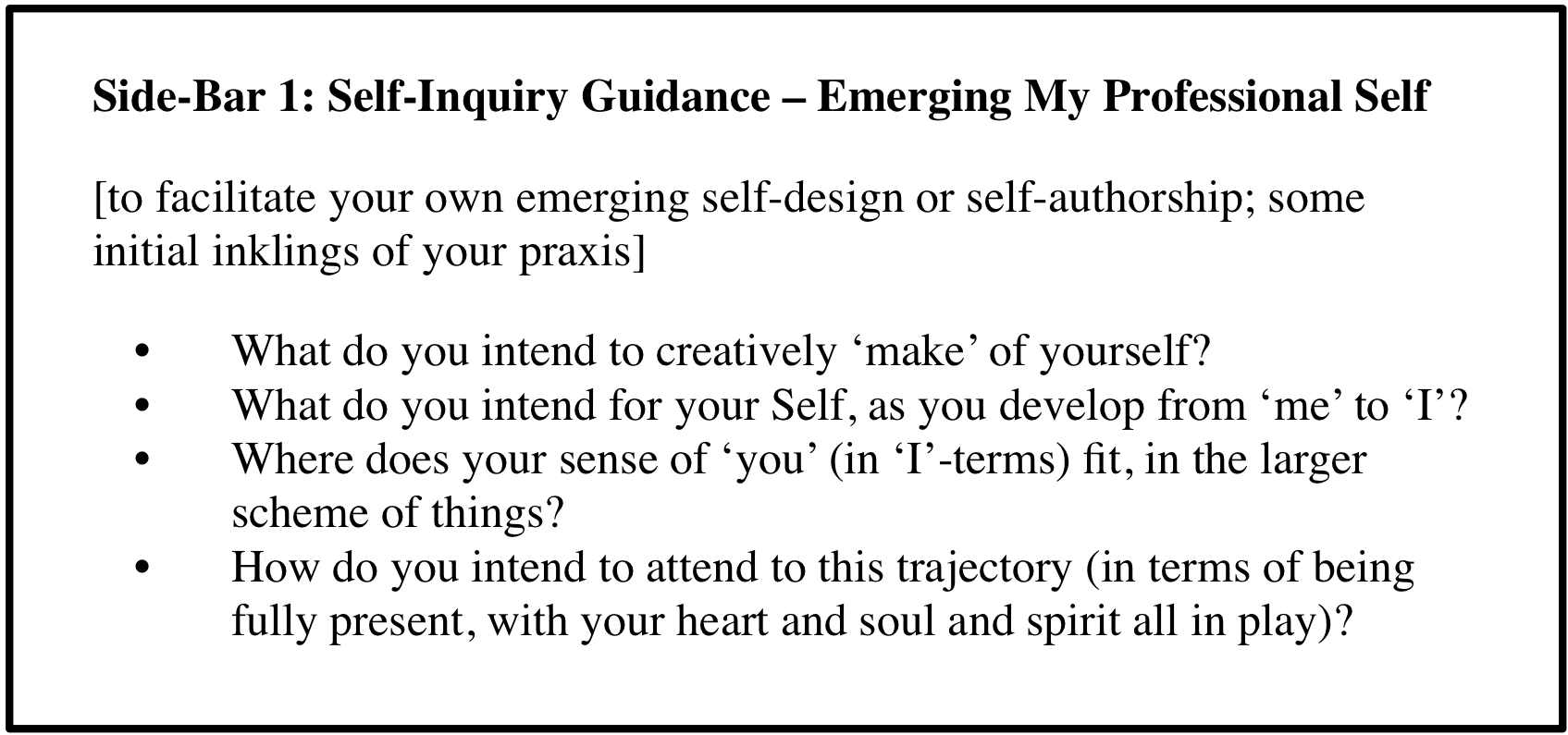
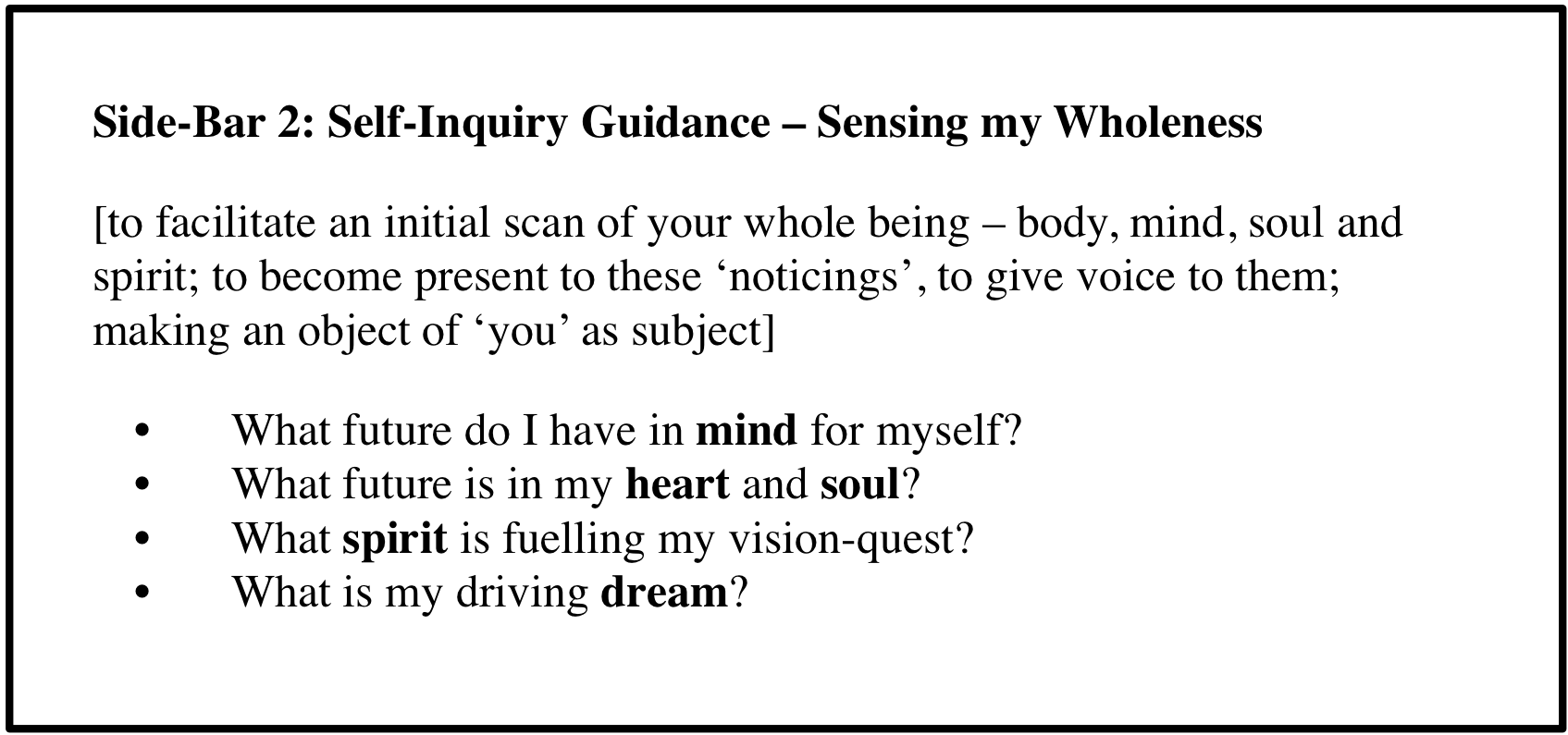
In personally approaching such professional self-inquiry I have noticed that I am best served by efforts to: be discriminating, by seeking to counter my Calculating Self and to cultivate my Central Self [iv]; be discerning, by noticing my False Self and presencing my True Self; be inspiring, by acknowledge my Unique Self, and the defining value perspectives I bring to bear; be fulfilling (full-filling), by bringing my Whole Self to all I do, and all I can be – Body, Mind, Soul and Spirit – giving it my all.
‘Self as Source’ is my call to be – to be a human being (and not simply a human doing); ‘be’ all I can ‘be’. How can this ‘you’ come to ‘be’? I believe a credo can be the vehicle – something that is simultaneously personal (Self as Source) and professional (Source as Us). I think of it as something I effectively wear on my sleeve, as a badge, identifying a team of sorts – with the collective goal of making a difference. But how can all this be grounded? What’s behind all this ‘be’-ing? Setting out on such a journey the question becomes: what might my compass look like?
Mapping Praxis – the Compass in my bearing
How might I begin to organize the output of my professional-self-inquiry? I begin – simply – by ‘noticing what I’m noticing’, about what is really grabbing my curiosity, sparking my wondering. I feel called to mobilize my whole self – body, mind, heart and soul – and to ‘go for the gusto’. More pragmatically, I feel drawn towards deeper discernment around certain ‘pairings’ – of inner dimensions and outer manifestations.
I picture my praxis in terms of such pairings that matter, and which merit aligning and embodying: self and service; soul and role; spirit and purpose. Such ‘pairings that matter’ – that engage mind, and soul and spirit more directly, and intentionally – help me begin to flesh out my professional praxis. My praxis is my way to convey how I make these connections, what I intend, and what I attend to, as a matter of course[v] (see Figure 5).
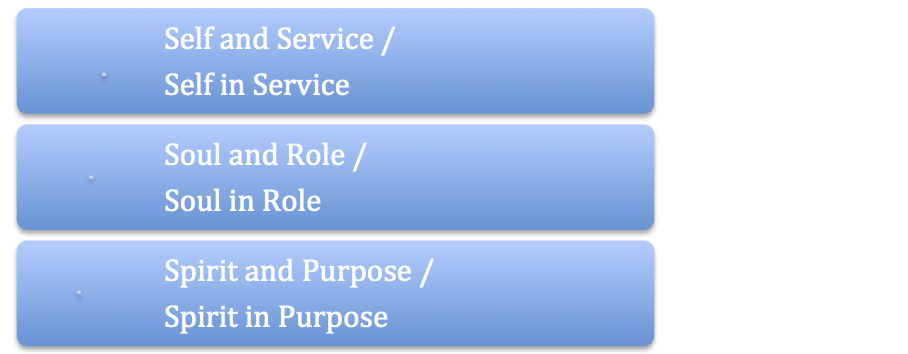
Figure 5. Pairings that Matter: To be Aligned
These cue me to what praxis-making is all about; for example:
- Serving with my whole self engaged – bringing my whole self to work;
- Manifesting my role as a whole; in the whole-making business; putting my heart into it; my soul on show
- Realizing my purpose as my inspiration – as spirit-in-action, a force for wholeness; my spirit at work/as work
- Reaching beyond any job, beyond any career – approaching work as a pilgrimage of identity[vi], of ‘I-dentity’
- Transcending the small ‘me’ – giving form to my grand ‘I’
In total, these amount to a considerable ‘presence’ on my part – of the whole, my whole, as a whole[vii]. I am consciously presencing myself, in the professional domain. I view this presencing as the manifestation of a series of larger inter-related ‘makings’ – sense-making, meaning-making and place-making. This is what I am presenting, and being present to, as integral parts of my praxis; my presencing in Praxis is through Being, Meaning and Discerning – which I speculate to be, respectively, the territories of praxis, ethos and poiesis (see Figure 6).
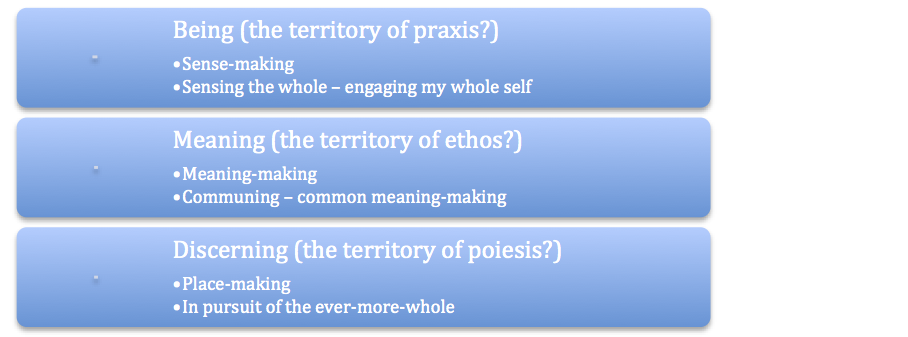
Figure 6. Presencings: To be Integrated
Just as my praxis is mine to make, there are particular ‘makings’ in Praxis – at its most evolved. Sense-making involves making sense of my world, through the senses that we are all equipped with. Meaning-making is, ultimately, something we do with others – establishing what is meaningful, meaning-filled… in common. Place-making builds on both – it is a fundamental human act, which we may regard here as a form of poetry-in-action on a grand scale, rippling with truth, goodness and beauty. These are the possibilities, the potentials, in All of Us.
I distinguish professionals – at their base, in their core – by their praxis and how they presence their praxis-making. Presencing becomes the ground-work for a series of ‘makings’; it especially features the more ‘personal’ territory, dominated by sense-making. In this way then, those with a praxis may gain the focus that leads to articulating a common inter-personal ‘ethos’ (akin to a credo), featuring meaning-making. And those with an ethos can then attempt acts of poiesis – a form of trans-personal poetry-in-action – on an epic scale; possibly the most evolved form of place-making. This triadic manifestation is the context for Praxis – praxis writ large.
At its heart, praxis-making involves myself in presencing an integration of three stances or ‘standings’ – being, meaning, and discerning – bequeathing an uncommon ‘over-standing’ of myself: being professional + comprehending the meaning in being professional + being discerning about being professional. What might be our current over-standing of our emerging professional self? [See Side-Bar 3].
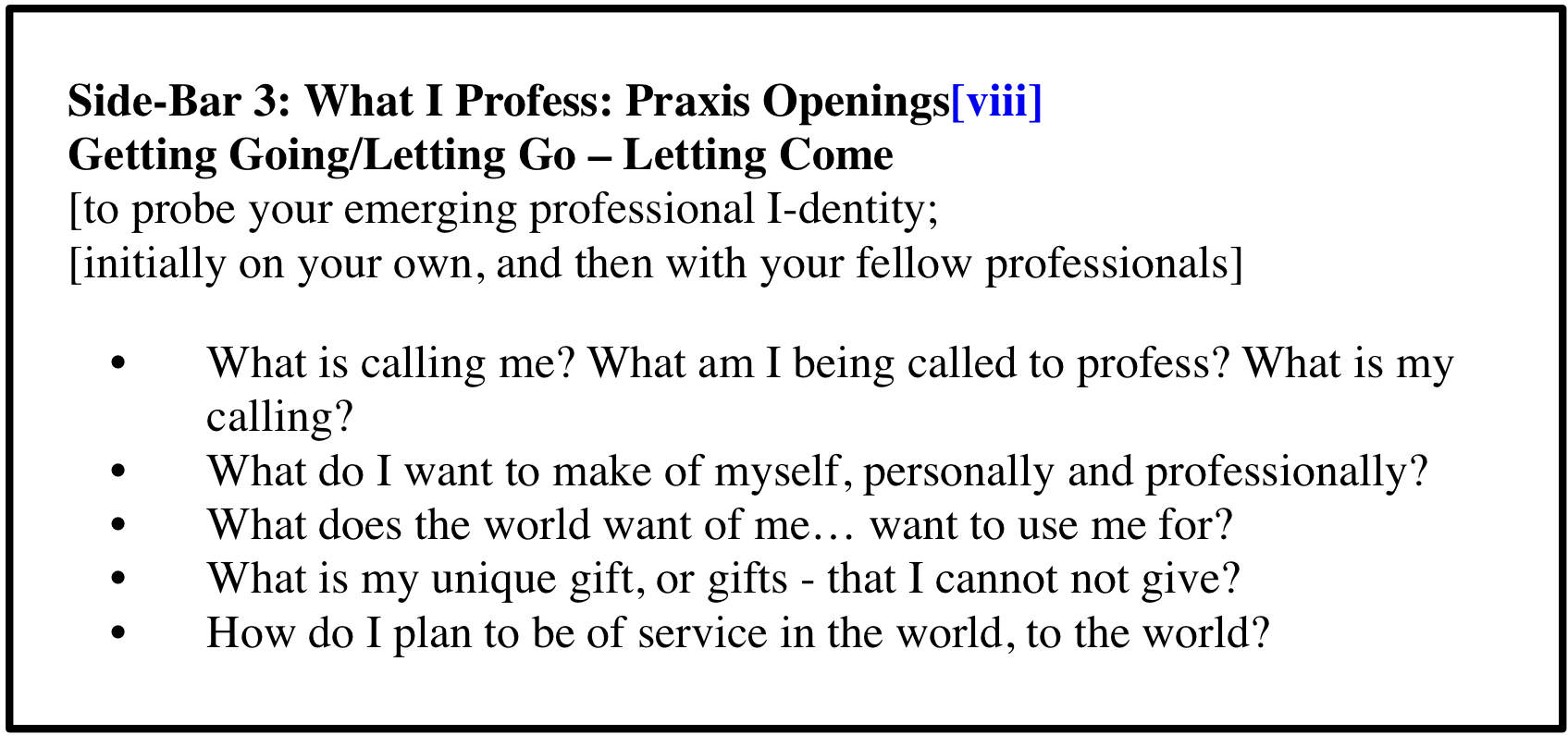
These lines of questioning should help us map out our praxis, each response serving as a bearing on our compass[ix]. They will yield a heading, and a hearting – mind-setting and heart-setting. Paraphrasing Thomas Berry, this could be our anticipation of our own ‘great work’, our contribution to ‘our way into the future’[x].
Wonderings – The Interface as Leading-Edge?
What might be emerging here? What could this be leading to? I initially developed this exploration for a non-integral pan-professional audience (with ‘integral’ deliberately positioned very much in the background, presentation-wise). I was attempting – implicitly – to acknowledge the often strong privileging of ‘practice’, and the comparative disparaging of ‘theory’, by practitioners, once we are ‘out of school’ and operating ‘in the real world’. I sought to support any serious interest in better integrating theory and practice, through a larger view of practice as praxis. I mobilized the notion of praxis to help better reconnect the personal and the professional – because too often, it seemed to me, we treat them as ‘poles’, to be kept apart. I believe an integral framing of praxis naturally favours a bridging of such divides, but – more intriguingly – the integration it offers also encompasses the possibility of better reconnecting the spiritual dimension into my/our professing. Some ‘whole-making’ is in prospect.
Does all this constitute an advancing of professional education; does it represent an integral advance on the status quo? My sense is that the jury is very much still ‘out’ on such determinations. For example, I have so far been unable to attract mainstream interest in such material, from publications oriented to practitioners within my own professional field. I have therefore wondered if there is a more basic disconnect to be reckoned with, around attempts to interface the integral and the professional.
As I have experimented writing this article, primarily in the first person active voice, it occurs to me that I may have encountered an ironic positioning in the professions that reinforces this disconnection – namely, the expectation to write our reports and scientific journals in the third person, passive voice. In contrast, my positioning here, trying to be true to my integral self, has involved making an object of what has been a subject inside of me – an act of (vulnerable) subjective expression; the old professional (even in myself) prefers to keep their objects for contemplation firmly outside of themselves. Not surprisingly therefore, an (integral) act of such personal subjective expression (characterized in the Action Research I am attempting to convey here) has had to contend with the pull of the usual professional objective expression in the passive voice (emblematic of much scientific, empirical literature). My own experience here has involved related discomfort that I have had to work to overcome; I wonder how much this is also uncomfortable for others; is it still outside our typical “professional” comfort zone (potentially further blocking our readiness and willingness to change)?
I have noticed that in some circles ‘integral’ has been represented as ‘post-disciplinary’[xi], yet most professions are very much discipline-based. Many of these disciplinary contexts are quite challenged by multi-disciplinary or inter-disciplinary overtures and initiatives; integration does not come easily after so much reductionism, and the associated fragmentation and disaggregation. In such a context, the notion of an ‘integral professionalism’ may amount to tilting at some very established windmills. Should I be casting myself as a post-post-modern Don Quixote, and steeling myself for more rebuffing by the mainstream?
My own personal practical encounter with ‘integral’ remains largely emboldening and empowering. It has helped me to an integral appreciation of an ancient classical ideal, what I define as integral praxis. It has underpinned a larger mesh-working project – meshing the personal, the professional and the spiritual. Its evolutionary impulse is driving some activism in myself around ‘evolving professionalism beyond the status quo’, and some associated dreaming around the possibility of tomorrow’s ‘professionals’ coming to merit the moniker of ‘integrals’, conceived potentially as ‘agents of the next enlightenment’. Is this leadership, or is this tilting at windmills? Where is the appeal – for an evolution of ‘the professional’ (in integral circles), or for an injection of ‘the integral’ (in mainstream contexts)? The integral/professional interface is a place of curious wondering and ongoing inquiry.
For example, might have I discovered that ‘professional’ is passé[xii] in integral company? Or is it simply a case of integral having ‘transcended, while including’ professional? Perhaps, if integral is essentially post-disciplinary, then it is also essentially ‘post-professional’. And, in integral circles especially, is it possible that ‘professional’ has been usurped by leadership framings? It can often seem that ‘the buzz’ is more around leadership development (than professional development), management education, (rather than professional education), and organization development (rather than profession – or professionalism – development). When it comes to what’s cool, or sexy, or hip… ‘professional’ does not seem to cut it. Might integral praxis make a difference?
Drawing on the insights of Spiral Dynamics, we may also locate the integral/professional interface around the transition from first-tier to second-tier. Perhaps professionalism is a prime marker of modernity, perhaps even epitomizing modernity in many respects? With its pre-modern and postmodern antecedents, I am wondering if modern professionalism can now be more clearly regarded as emblematic of ‘first-tier’ at work; maybe ‘first-tier’ is the tier of the ‘professional’?
To the extent that second-tier is associated with ‘integral’, we must expect major contrasts – along with associated jockeying for the lead position. The leading-edge is currently around the juncture of late-first-tier and early-second-tier; we are negotiating some messy middle-ground. An integral framing of an old ideal might ease our way. This would be an integral manifestation of ‘more than modern’ professional practice – embracing calling, credo and compass, and ultimately tapping the spirit in praxis. As second-tier matures, vision-logic might yet yield integrals, as transformations of first-tier professionals – evolved equivalents, serving as embodied agents of the next enlightenment. Vision-logic, or wish-filled thinking, or dreaming ‘the impossible dream’: where might this lead us, as we negotiate the professional/integral interface?
References
Astin, A.W., Astin, H.S., & Lindblom, J (2011) Cultivating the Spirit: How College Can Enhance Students’ Inner Lives. Jossey-Bass.
Berry, T (1999). The Great Work: Our Way into the Future. Bell Tower: New York
Friesen, E. and Wight, I. (2009). ‘Integrally-Informed Journaling for Professional Self-Design: Emerging Experience in a Graduate Program Context’. Journal of Integral Theory and Practice 4(3): 59-86.
Nicolaides, A. & McCallum, D.C. (2013). Inquiry in Action for Leadership in Turbulent Times: Connections Between Transformative Learning and Adaptive Leadership. Journal of Transformative Education 11(4):246-260.
Palmer, P.J. (2004). A Hidden Wholeness: The Journey Toward an Undivided Life (Welcoming the Soul and Weaving Community in a Wounded World). Jossey-Bass/Wiley.
Senge, P.M., Scharmer, C.O., Jaworski, J. and B-S. Flowers (2008) Presence: Human Purpose and The Field of the Future. Random House
Whyte, D. (2001) Crossing the Unknown Sea: Work as a Pilgrimage of Identity. Riverhead.
Whyte, D. (2010) The Three Marriages: Re-Imagining Work, Self and Relationship. Riverhead
Wight, I. (2005) ‘Place-making as Applied Integral Ecology: Evolving an Ecologically-Wise Planning Ethic’, World Futures 61: 127-137.
Wight, I. (2011) ‘From Codified Ethics to Co-Created Ethos: Staking Common Ground in Uncertain Times’. Plan Canada, Winter 2011, 32-35.
Wight, I. (2012). ‘Praxis + Ethos + Poiesis: The Making/s of Professionals – An Elephant of a Professional Self-Design Project’. Warehouse 2012, 78-81 (The Journal of FAUM Students).
Wight, I. (2013). ‘Exploring Inter-Being and Inter-Becoming – as Ethos-Making: The Integrally-Informed Pursuit of Professional Community Wellbeing’. Journal of Integral Theory and Practice 8 (3&4) 82-96.
Wight, I. (2014). ‘Enabling Professional-Self Design: Educating for Praxis, Ethos and Poiesis’, 2nd Annual Association of Architectural Educators (aae) conference, Living and Learning – Conference Proceedings, pp 100 – 104 (Sheffield UK)
Zander, R., and Zander, B. (2002). The Art of Possibility: Transforming Professional and Personal Life. Penguin Books
Endnotes
[i] For more background and details on this work see Friesen and Wight (2009), Wight (2012), and Wight (2014).
[ii] I was an inaugural member of the Integral Institute, and one of the founding members of the Integral Ecology group within the Institute (Wight, 2005).
[iii] For some insights on ethos-making see Wight (2011) and Wight (2013). Work on an integral professional framing of poesis is very much a ‘work-in-progress’, but it is anticipated to include initiatives such as Collaborative Developmental Action Inquiry (Nicolaides and McCallum, 2013).
[iv] The distinction between one’s ‘central’ self and one’s ‘calculating’ self is made in some of the practices featured in The Art of Possibility, by Rosamund and Benjamin Zander (2002).
[v] These ‘pairings’ featured prominently in Wight (2011) ‘From Codified Ethics to Co-Created Ethos’ Plan Canada – Winter 2011 Vol. 51:4, 32-36.
[vi] David Whyte is a poet and author who can provide inspiration for some. See for example his books, Crossing the Unknown See: Work as a Pilgrimage of Identity and The Three Marriages.
[vii] For more on this notion of presence (which may be related to your sense of your prof-essence) see the book of the same name, Presence: Human Purpose and the Field of the Future (2008) by Peter Senge et al.
[viii] This particular set of questions provided the orienting context for the Professional Practice course that provided the crucible for innovating the praxis-making discussed here. The course was operated as a ‘professional-self design studio’; the questions were intended to prime the design inquiry. The main inputs were generated by the students themselves in the course of integrally-informed journaling (Friesen and Wight, 2009), supporting their ‘preliminary praxis statement’ work.
[ix] For a sense of my own praxis I would refer the reader to the draft ethos-statements, Quiet Resolve and Agency in Communion, discussed – respectively – in Wight (2011) and Wight (2013). I led the drafting of these, and became aware – in the process – of how my own praxis was embedded within them.
[x] Thomas Berry (1999). The Great Work: Our Way into the Future. Bell Tower: New York
[xi] For example, the Journal of Integral Theory and Practice is represented, sub-title-wise, as ‘A Postdisciplinary Discourse for Global Action’
[xii] Passé: past its prime; outmoded; behind the times; no longer fashionable or popular.
About the Author
Ian Wight is a Senior Scholar affiliated with the Department of City Planning, University of Manitoba. He was responsible for the UM CP capstone Professional Planning Practice course for 20 years, and this article reflects some of his learning experiences. Ian is currently working on a possible series of articles on: the making/s of professionals (praxis/ethos/poiesis); on ‘journaling praxis’ (great places; primal relationships; and unique self); and on evolved forms of professionalism (neo-civic professionalism, inter-professionalism, and meta-professionalism).
Contact:
Email: Ian Wight Ian.Wight@UManitoba.CA ianwight1949@gmail.com

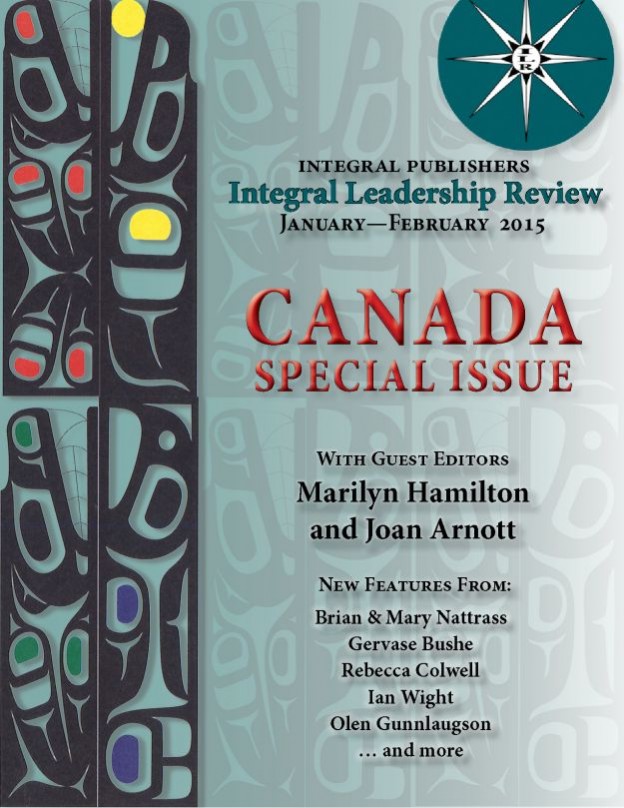
Ah, Ian, what a marvelously inspiring and vulnerable and thought-provoking exploration! Thank you! Many responses arise in me, and I will include a few right here.
Is a professional a professional a professional? I suspect there are some professions who are more receptive to your approach. Look for the lowest windmills, LOL! Another low windmill might be “professionals” who abound within the Integrally-informed community, have you not found an interested ear there?
A lot of “dots” occur to me as related in my head, and perhaps relevant for your further explorations. I heard echoes here of what little I know of Diane Hamilton’s Integral Facilitator training, which I gather emphasizes “showing up” as a group leader, as one’s FULL self. I also wonder about the possible relationship of what you’re describing to the “Presence-Centered Evolutionary Leadership” concept (possibly dormant) program from Alain Gauthier, Terri O’Fallon and others. In fact, I think you’re right in surmising that perhaps “leadership” is the arena of Integral interest in which matters of your interest are being explored, experimented with, and addressed. Do you think so?
On a more meta-level, in my own informed but admittedly idiosyncratic interpretation of SD, concern with embodying practices actually doesn’t kick in bigtime until Turquoise moving into Coral. So perhaps you are more ahead of the curve than you even thought. (As I suggest here: http://exploringsecondandthirdtier.blogspot.com/2013/11/third-tier-we-spaces-coral-and-teal.html
” We might say [about Coral We-space consciousness] that the “state” of emergent collective consciousness-field is becoming a “state-stage.” It tends to emerge in individuals when they are in the least proximity to one another, without “practice” and without consciously adopting or abiding by “injunctions,” which have become habits now. Individuals experienced in CORAL We-space, tend to act as automatic “inducers” so the phenomenon starts to show up via transmission or radiation, in other contexts of their life,…” (Can’t find a more focused quote right now.)
However, that natural move into Coral consciousness around shifting from practices into embodying (which reaches completeness IMO only in the next stage, 2nd stage of 3rd tier, Teal, in SD colors) CAN I suspect be “translated down” to hook up with some of the natural movements from Green into Integral, such as willingness to expand perspectives and see wholeness at least as “systems” or as a broader grouping of “us.”
Finally, a few more dots:
Mikyo Clark’s chapter on Leadership in the book The Coming Waves – Evolution, Transformation, and Action in an Integral Age, and Andrew Venezia’s Master’s thesis I, We, All: Intersubjectivity and We Space, Post-Metaphysics, and Human Becoming both seem to me to reflect wonderful descriptions/examples of the kind of very “whole” approach to being a professional which you are describing.
Thank you again, and thanks to the editors of this fine Canadian issue, and to all the folks at ILR who are so dedicated and awesome!